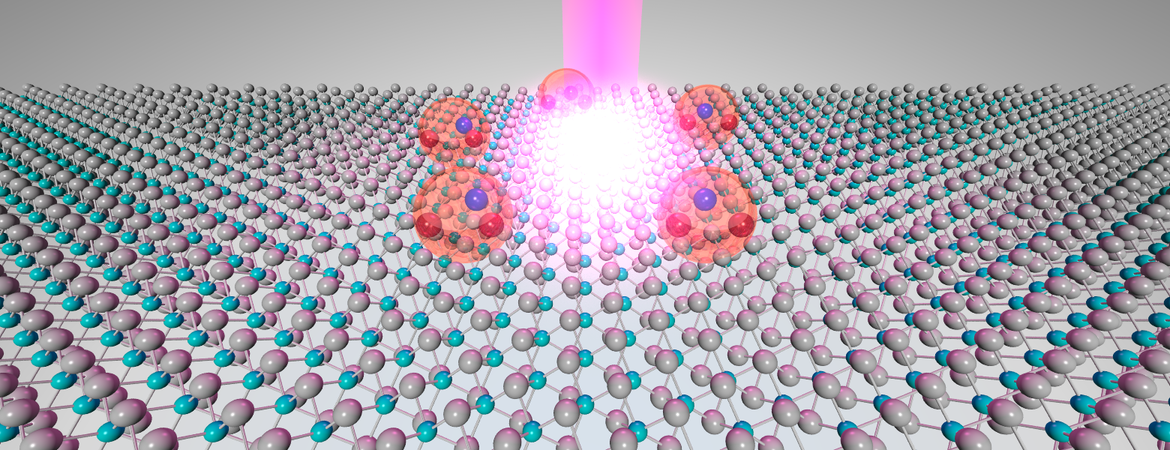
Move aside, electrons; it’s time to make way for the trion.
A research team led by physicists at the University of California, Riverside, has observed, characterized, and controlled dark trions in a semiconductor — ultraclean single-layer tungsten diselenide (WSe2) — a feat that could increase the capacity and alter the form of information transmission.
In a semiconductor, such as WSe2, a trion is a quantum bound state of three charged particles. A negative trion contains two electrons and one hole; a positive trion contains two holes and one electron. A hole is the vacancy of an electron in a semiconductor, which behaves like a positively charged particle. Because a trion contains three interacting particles, it can carry much more information than a single electron.
Most electronics today use individual electrons to conduct electricity and transmit information. As trions carry net electric charge, their motion can be controlled by an electric field. Trions can, therefore, also be used as information carriers. Compared to individual electrons, trions have controllable spin and momentum indices and a rich internal structure, which can be used to encode information.
Trions can be categorized into bright and dark trions with distinct spin configurations. A bright trion contains an electron and a hole with opposite spins. A dark trion contains an electron and a hole with the same spin. Bright trions couple strongly to light and emit light efficiently, meaning they decay quickly. Dark trions, however, couple weakly to light, meaning they decay much more slowly than bright trions.
The researchers measured the lifetime of dark trions and found they last more than 100 times longer than the more common bright trions. The long lifetime enables information transmission by trions over a much longer distance.
“Our work allows the writing and reading of trion information by light,” said Chun Hung (Joshua) Lui, an assistant professor of physics and astronomy at UC Riverside, who led the research. “We can generate two types of trions — dark and bright trions — and control how information is encoded in them.”
The results of the research are published in the journal Physical Review Letters.
“Our results could enable new ways of information transmission,” said Erfu Liu, the first author of the research paper, and a postdoctoral researcher in Lui’s lab. “Dark trions, with their long lifetime, can help us realize information transmission by trions. Just like increasing your Wi-Fi bandwidth at home, trion transmission allows more information to come through than individual electrons.”
The researchers used a single layer of WSe2 atoms, resembling a graphene sheet, because the dark trion energy level in WSe2 lies below the bright trion energy level. The dark trions can therefore accumulate a large population, enabling their detection.
Lui explained that most trion research today focuses on bright trions because they emit so much light and can be easily measured.
“But we focus on dark trions and their detailed behavior under different charge densities in single-layer WSe2 devices,” Lui said. “We were able to demonstrate a continuous tuning from positive dark trions to negative dark trions by simply adjusting an external voltage. We were also able to confirm dark trions’ distinct spin configuration from bright trions.
“If we can use trions to transmit information, our information technology will be greatly enriched,” he added. “The major obstacle in such a development has been the short lifetime of bright trions. Now the long-lived dark trions can help us overcome this obstacle.”
Next, his team plans to demonstrate the actual transport of information by dark trions.
“We intend to demonstrate the first working device that uses dark trions to transport information,” Lui said. “If such a prototype trion device works, dark trions can then be used to transport quantum information.”
The research was supported by UCR startup funds.
Lui and Liu were joined in the study by Jeremiah van Baren and Mashael M. Altaiary of UCR; Zhengguang Lu and Dmitry Smirnov of the National High Magnetic Field Laboratory, Florida; and Takashi Taniguchi and Kenji Watanabe of the National Institute for Materials Science, Japan.
(Header image shows optical generation of trions in single-layer WSe2. Credit: Erfu Liu, UC Riverside.)



